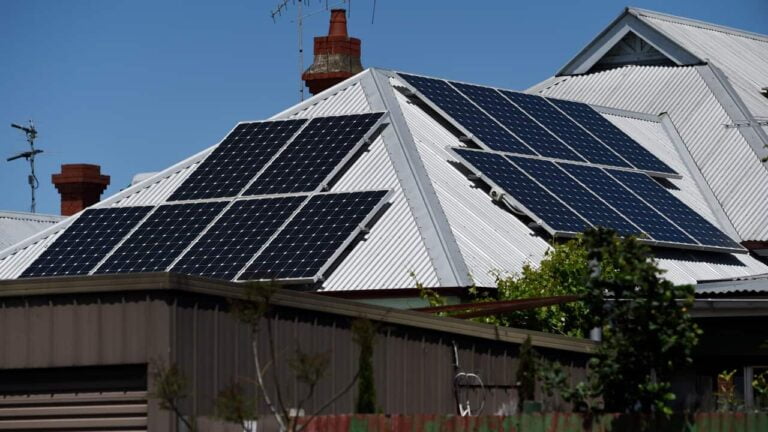Main Points
- Solar panel production may have links to slave labor, experts say.
- They also say that many low-quality panels are unsustainable.
- Human rights lawyers are calling for government reform.
Australia should approach its renewable energy transition with caution, experts say, amid concerns over labor exploitation in the production of solar panels.
Polysilicon is the most common material used to make solar panels, and about 45 percent of the world’s supply comes from Xinjiang, China.
the with experts accusing the Chinese Communist Party (CCP) of exploiting its Uyghur Muslim minority into forced labor to produce products including solar panels.
China has strongly denied the allegations of human rights abuse against it .
Are solar panels made by slaves?
Solar panel production is linked to slave labor, according to Martijn Boersma, an associate professor of modern slavery at Western Australia’s University of Notre Dame.
“Unfortunately, the innovation intended to address climate change may be linked to the exploitation of workers,” he said.
“Producers of solar-grade polysilicon are connected to Uyghur forced labor – directly by participating in state-sponsored forced labor schemes, or indirectly by obtaining their raw materials.”
Mr Boersma said cobalt, a mineral used to make electric cars, was also often linked to slave labour.
If the goals are met, cobalt demand could increase up to 25 times from current levels in the next two decades.
“This is a problem because about 70 percent of the cobalt comes from the Democratic Republic of Congo, where many workers are victims of labor abuses, including low wages, unsafe working conditions, and even of the child,” he said.
“Both solar-grade polysilicon and cobalt are important for the transition to green energy, but we must not turn away from the abusive working conditions that pollute the origin of these materials and the production of solar panels and batteries. “
Freya Dinshaw, a senior lawyer at the Human Rights Law Center (HRLC), said the Australian government should change the to prevent links between slave labor and the supply chains of Australian companies.
“It has been released by the HRLC of the Modern Slavery Act, and what the amendment will do is introduce a new duty to prevent modern slavery,” he said.
Under Australia’s current modern slavery law, companies are only required to report risks in their supply chains, and there are no penalties for non-compliance.
“Under this proposal, companies will have to undertake due diligence to identify, assess and address the risks of modern slavery, and will be held accountable where they fail to do so,” Ms Dinshaw said.
“Workers subjected to modern slavery can also seek direct remedies from companies unless the companies can demonstrate that they took all reasonable steps to prevent abuses from occurring.”
The Program Manager of the Campaign for Uyghurs in Washington DC, Arslan Hidayat, also said that the Australian government should do more to prevent products with links to slavery, such as solar panels, from being sold in Australia. .
Miners working at the Shabara artisanal cobalt mine near Kolwezi, Democratic Republic of Congo, in October. Source: AFP / Junior Kannah
“There seems to be a fight between what is more important: climate change or human rights,” he said.
“Obviously, they’re both very important issues. But you have these heartless, big conglomerate companies, using the excuse of climate change as a loophole to try and get their products out.”
Mr Hidayat said Australian companies should “have to prove that their products are not made from slave labour” before they are allowed into the country.
What is ‘energetic payback’, and why is it important for a solar panel’s carbon footprint?
As well as the alleged links to slave labour, there are also concerns about the quality of some solar panels and the energy used to make them.
Energetic payback is the time it takes for a solar panel to produce as much energy as it takes to manufacture the panel.
Michelle McCann from PV-Lab, an Australian company that focuses on quality assurance for solar panels, said the energy cost of a panel is important for its carbon footprint.
Solar panels at a power plant in Changji, Xinjiang province, China. Source: Getty / Costfoto/Future Publishing
“The longevity of a solar panel in practice is one of the biggest drivers of really strong payback time,” he said.
“A panel should last 25 years, any earlier replacement will have a significant impact on the energy payback time.”
Ms McCann said lower quality solar panels have a shorter life span and in turn, the energy required to manufacture them cannot be repaid.
“Troubles begin when, in order to keep costs as low as possible, manufacturers skim relatively cheap plastics that make the panels timeless,” he said.
Ms McCann said “similar factories in China” could produce high- and low-quality solar panels, and that consumers should be careful what they buy.
SBS News has contacted Energy Minister Chris Bowen’s office, the Chinese embassy in Canberra, and the Clean Energy Council for comment.
